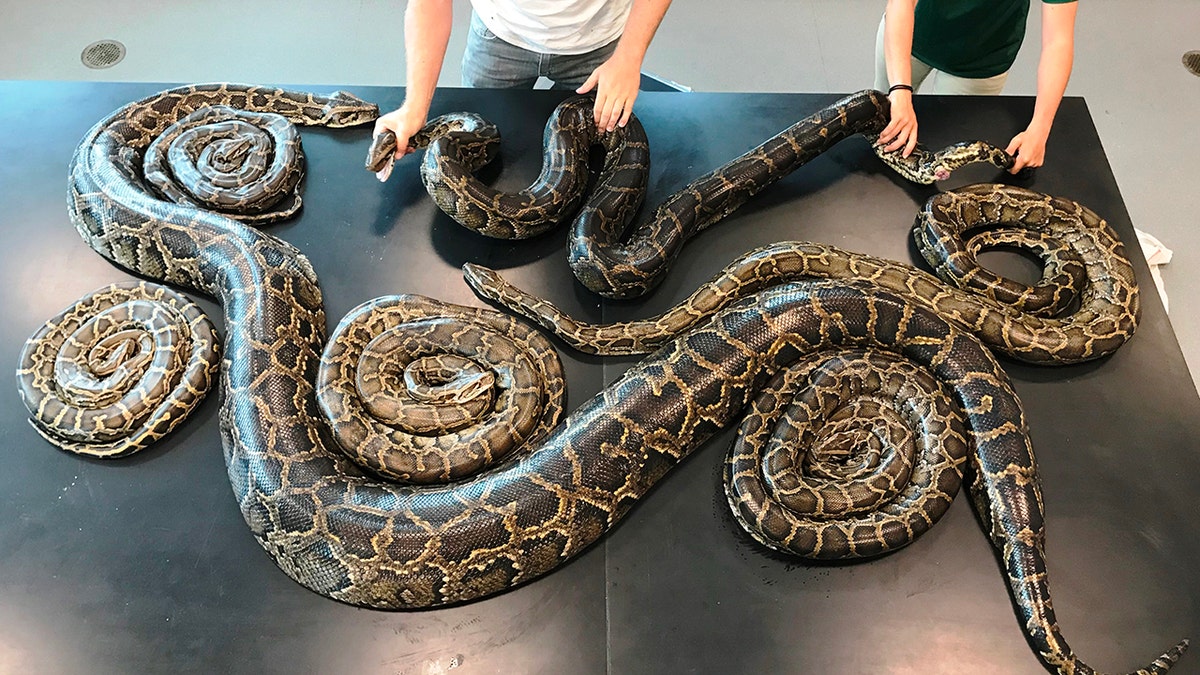
Florida wildlife biologists found a breeding aggregate, or snake sex party, with seven Burmese pythons - six males and one 115-pound female. (Conservancy of Southwest Florida)
A slithering sentinel male python equipped with a surgically implanted tracking device led Florida wildlife biologists to what they are calling a “breeding aggregation” -- or snake sex party.
Wildlife biologist Ian Bartoszek said they were tracking a Burmese python nicknamed Argo, who days earlier had helped them find a 100-pound female python ready to lay eggs.
On Valentine’s Day, Argo led them to what is being called the largest breeding aggregation ever discovered in Collier County, near Naples in Southwest Florida.
“We locate him and then there is another male, and another male and another,” Bartoszek, who is with the Conservancy of Southwest Florida, told the Naples News. “We know what all the males are for, so it’s like, where’s the female?”
The massive 15-foot-long, 115-pound egg-laying female was found nearby. There were a total of six male snakes – not including Argo.
“It was intense, it was a lot of snake in one spot,” Bartoszek told the Sun Sentinel.
The number of pythons, which are not endemic to Florida, has been steadily growing for years. The aggregation near Naples matches the largest found in the known hotbeds of the central and eastern Everglades.
The seven snakes found were euthanized. Argo was re-released for additional tracking.
The female had 60 eggs inside her and most of them would have hatched, Bartoszek affirmed. However, it’s unclear how many of those hatchlings would have survived.
The Conservancy of Southwest Florida have been using other male pythons like Argo to help track females, which biologists said are far more significant when it comes to population control because of the sheer number of eggs they can lay.
Biologists said part of what makes pythons difficult to track is they leave virtually no trace of their prey – small or large. The animals are swallowed whole and no carcass is left behind.
Wildlife experts estimate that 61 percent of a python’s diet are small mammals such as rabbits, opossums and raccoons. But there are exceptions.

Florida officials released photos of a 2015 case involving a python eating a deer as the case appears in a peer-reviewed Journal in March. (Conservancy of Southwest Florida)
Last month, the conservancy released photos of a Burmese python swallowing a whole deer. It was believed to be the “largest predator to prey ratio” ever documented in the history of the Burmese python species, the conservancy said at the time.
“You look at some 250 pounds of python and you think, what did it take to make that?” Bartoszek told the Naples News.
He said the conservancy removed about 2,000 pounds of pythons this year, and the same amount last year.
“It’s about removal, but it’s also about research,” he said. “As the technology advances we want to be able to follow the science. To really have an effective control we have to learn what we can learn about them and their habits to make informed decisions.”




















